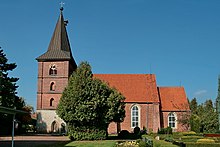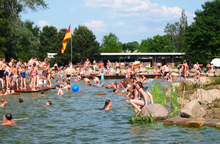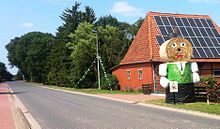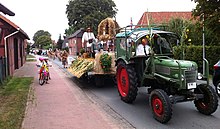Rodewald
| coat of arms | Germany map | |
|---|---|---|
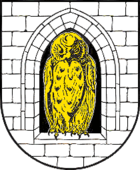
|
Coordinates: 52 ° 40 ′ N , 9 ° 29 ′ E |
|
| Basic data | ||
| State : | Lower Saxony | |
| County : | Nienburg / Weser | |
| Joint municipality : | Steimbke | |
| Height : | 25 m above sea level NHN | |
| Area : | 60.31 km 2 | |
| Residents: | 2537 (Dec. 31, 2019) | |
| Population density : | 42 inhabitants per km 2 | |
| Postal code : | 31637 | |
| Area code : | 05074 | |
| License plate : | NI | |
| Community key : | 03 2 56 026 | |
| Association administration address: | Kirchstrasse 4 31634 Steimbke |
|
| Mayoress : | Katharina Fick (Rodewald WG) | |
| Location of the community Rodewald in the district of Nienburg / Weser | ||
Rodewald is a municipality in the Steimbke municipality in the Nienburg / Weser district in Lower Saxony . The agricultural community is divided into three farming communities named Upper, Middle and Lower peasantry (abbreviated as o. B., mB and uB). On April 1, 1969, the three political communities of Rodewald became the unified community of Rodewald. Until the district reform in 1974 Rodewald was part of the Neustadt am Rübenberge district , since then the community has belonged to the Nienburg / Weser district.
geography
At around 11 kilometers in length, the village is considered the second longest village in Lower Saxony. The village is geographically relatively central in Lower Saxony, about 40 km north of the state capital Hanover and 125 km south of the Hanseatic city of Hamburg .
history
Rodewald was founded as a diocesan in the first quarter of the 13th century by the Counts of Wölpe with the approval of the Bishop of Minden. The foundation was part of a larger country development in their domain. In 1221 and 1223 a Christianus de Rodelwolde appears as a witness in two documents. A planned settlement resulted in the first section along a path, which is largely identical to today's lower farmers . The village probably owes its name to the associated deforestation, which is, according to its shape, a high medieval Hagenhufendorf village . Each settler received a piece of land of the same size, an enclosed, i.e. H. fenced-in hooves that stretched across the street in a strip and within which he settled and built his buildings. In addition, as a hunter, he enjoyed legal advantages, such as his own lower jurisdiction.
These pieces of land, between 60 and 70 acres in size, were only as wide as the courtyard, but very long. This hallway, which is typical of the High Middle Ages, can still be seen today if you drive along highway 192. By the middle of the 14th century, the village extended south and was expanded to include the middle and upper peasantry, who formed their own legal communities.
It wasn't until after World War II, when motorized transport and agricultural machinery became affordable, that settlement activity increased. More and more houses that were only used for residential purposes were being built on the open spaces along the state road, so that the formerly characteristic reciprocal development along the road is now more difficult to see. In consideration of today's benefits and landscape protection, the new buildings were mainly limited to the center and the southern industrial area. But where the historical settlement structure has been preserved, Rodewald, the "long village on the road", has retained its unique charm. The remaining open spaces along the road continue to interlock the landscape and the settlement.
religion
The two major Christian denominations are represented in Rodewald, and they gather for worship in two churches in Rodewald . There are no other denominations and religions that are institutionally represented in Rodewald .
The Evangelical Lutheran St. Aegidien and St. Johannis parish in Rodewald belongs to the parish of Nienburg and maintains two churches in Rodewald: the St. Johannis church in the lower peasantry and the St. Aegidien church in the middle Peasantry. The Protestant parish comprises approx. 2400 parishioners and maintains a joint rectory with the Protestant chapel community of the scattered Lichtenhorst settlement .
The Roman Catholic Church "Holy Family" was built in 1961/62 in the northern part of the village, on the path named after the founder and long-time pastor of the community Georg Wengler. In 1962 the neighboring Catholic senior citizen center "Heilige Familie" was opened, it is today in Protestant sponsorship. Since 2006 the church belonged to the parish of St. Bernward in Nienburg, it was profaned in 2015. The Nienburg pastor now looks after the approx. 350 members Another Protestant St. George's Chapel existed in the former schoolhouse of the upper peasantry at the Krummende.
politics
Municipal council
The council of the Rodewald community consists of 13 councilors. This is the specified number for the member municipality of an integrated municipality with a population between 2001 and 3000 inhabitants. The council members are elected for a five-year term by local elections. The current term of office began on November 1, 2016 and ends on October 31, 2021.
The last local election on September 11, 2016 resulted in the following:
| Political party | Proportional votes | Number of seats |
|---|---|---|
| CDU | 40.43% | 5 |
| Rodewald flat share | 31.68% | 4th |
| SPD | 25.22% | 3 |
| FDP | 2.66% | 1 |
The turnout in the 2016 local elections was 61.43%, above the Lower Saxony average of 55.5%.
mayor
The council elected council member Katharina Fick (WG Rodewald) as honorary mayor for the current electoral term.
- Previous incumbent
- ~ 1970: Hermann Frerking
- 1972–1986: Herbert Schöling (CDU)
- 1986–1996: Fritz Thieße (CDU)
- 1996-2007: Herrmann Bartels (CDU)
- 2007–2011: Hans-Joachim Zilke (SPD)
- since 2011: Katharina Fick (shared flat)
- Community director
- ~ 1970: Heinrich Krage
- 1971 Gustav Graubohm
- 1972 Uwe Wanner
coat of arms
The municipal coat of arms of the village community Rodewald mB with the owl in the opening of a church window (Lichtgade) was founded in 1960 by the provincial government in Hanover approved and adopted by the founded in 1969 unified community. The motif of the owl comes from a small stone owl in the portal of the tower of the St. Aegidien Church in Rodewald mB The council of the community Rodewald has decided against the release for use on the Internet.
traffic
Street
Two important streets cross in the center of Rodewald. The federal highway 214 runs from Nienburg / Weser to Celle in an east-west direction ; this intersects the state road 192, which leads in a north-south direction from Lichtenhorst to Neustadt am Rübenberge . The federal motorway 7 runs about 15 km east of Rodewald.
bus and train
The bus connection (line 40) to Nienburg / Weser is mainly geared towards transporting schoolchildren. The nearest train station is in Schwarmstedt , but it cannot be reached by public transport.
air
The closest commercial airport is Hanover Airport, about 30 km south-east .
Sport, recreation and culture
Buildings
St. Aegidien Church
The St. Aegidien Church, located on the border between the Middle and Upper Peasantry, is a late Romanesque brick building from the middle of the 13th century. Around 1523 the nave windows were extended. The three upper floors and the spire were rebuilt after a fire in 1821 after 1849. In 1965-1965 the late baroque interior was removed and the interior returned to its original state. Wall paintings from the late 13th century were uncovered. Two modern windows in the chancel depict the "Arrival of Christ" and the "Second Coming of Christ".
St. John's Church
The Johanniskirche in the lower peasantry is the oldest of the two Rodewald churches. The current hall church with square choir was built in place of a previous building in the middle of the 14th century, the barrel-vaulted sacristy and the roof turret in 1752. The east and west gables of the brick building were designed in detail with flat wall niches. In contrast to the east gable, the west gable was restored in 2003. The roof was restored several times in the 15th and 18th centuries. The interior impresses with its low cross vault.
Paltrock windmill
The Paltrock windmill in the lower peasantry is one of the few remaining Paltrock mills, an intermediate stage between the post and Dutch windmills. At the same time, it is an example of the adaptation of mill technology in the 20th century. It was converted in 1935 by the mill construction company Karl Kühl from parts of a post mill that had been there since 1890, which itself came from Rethem an der Aller, and parts of other mills. Although the blades and wind rose are missing today, the grinder is still fully functional and powered by an electric motor.
The local museum
The Rodewald Local History Museum was initiated in 1982 by the students Ulf Bohnhorst and Holger Rabe with the support of the community and operated by a museum association. It is located in a half-timbered building that was built in 1877 and has been used as a medical practice since the beginning of the 20th century. In addition to the inventory that has been preserved, there are exhibits on the rose pharmacy and on country life in earlier centuries.
societies
Most of the residents of Rodewald are involved in one or more of the approximately 25 different associations in the village. The largest of these are:
SSV Rodewald
The Rodewald game and sports club was founded in 1975. Through a merger of the two former sports clubs SV Vorwärts from 1921 and TSV Rodewald from 1924, the current SSV Rodewald e. V. from 1921. The largest division in the SSV is football, which has teams in almost all youth classes and is represented by two teams at district level. In addition to football, handball, gymnastics, children's gymnastics, athletics, table tennis, Nordic walking, Zumba and hiking are also on offer. The club uses a gym, two training grounds and a stadium with a sports center that was inaugurated on May 7, 1982.
Rifle clubs and the marching band
Rodewald has three shooting clubs. Each peasantry houses its own rifle club with different uniforms that can be traced back to the time as a local militia. Even if the military aspect of shooting clubs has long been a thing of the past and shooting is purely sporty, there are rivalries between the clubs. Each SV has its own shooting club and also its own shooting festival (see below), with its own king, queen, youth, child and dwarf king. The weapons used to hold the competitions are air rifles , small bore rifles and laser rifles . Every year the 3 rifle clubs determine the owl king and shoot for the alpine cup. The Rodewald rifle clubs joined the Wilhelm Tell shooting association. The majesties of the eight member clubs are also eliminated annually. In 1927 the first drummer and piper corps was founded at the Rodewald mB shooting club, but this was dissolved by the war. In 1969 members of SV Rodewald o. B. from 1911 founded the Rodewald Spielmannszug , which was headed as an independent group by the then board members. The premiere took place at the shooting festival in 1970 in Rodewald o. B. Today the SZ is invited to many shooting and harvest festivals in the neighboring villages and is even represented at the largest shooting festival in the world in Hanover every year.
Preciosa theater association
At Easter in 1921 the Preciosa theater association was founded. It is divided into a children's group, in which local children between the ages of 4 and 16 rehearse a fairy tale every year and perform it during Advent, and the adult group, which goes to great lengths to primarily maintain and maintain the Low German dialect. Due to the cultural peculiarity of the pieces in Low German , the "Preciosen" managed to achieve some success. So they step u. a. regularly once a year in the Theater am Hornwerk in Nienburg / W. on.
Riding and driving club
The riding and driving association founded in 1921 enjoyed great popularity until the Second World War, when the horses were confiscated for war purposes. After the war, the first training facility was built in 1958 in the hall of the “Zum Keller” inn. In 1967 Rudolf Duensing-Knop took over the management of the association. During his tenure, the club achieved a lot of prestige and success in tournament sports. The number of participants grew continuously and could finally no longer be managed by the association. In 1980 the newly built riding arena was put into operation. Today, various disciplines such as dressage, show jumping, eventing, vaulting, driving, leisure and western riding, gymnastics on horseback and natural horsemanship are offered, and the annual horse show still takes place on a small scale.
Choral societies
Male Choir Rodewald uB
On November 10, 1890, several men who enjoyed singing got together and founded the MGV Rodewald uB. After many successful years, the outbreak of the First World War brought a painful loss of active singers, but as early as 1919 the singers came together again to serve the German song and it revived the old tradition of the club to celebrate a singing ball. With the outbreak of the Second World War, the club life paralyzed again as many members were drafted. In November 1946, the singing evenings were resumed in the Karl Näther clubhouse. At the end of 1963, the MGV joined the Soltau-Fallingbostel singing group . In the following years the choir formed a loose singing community with the MGV Gilten. Since the choir lacks the young singers, there are currently only sporadic singing evenings in a private atmosphere.
mixed choir
The mixed choir was founded on November 5, 1892 as a men's choir by 20 men from Rodewald o. B. and mB. In 1960, the MGV of 1892 became the Rodewald Mixed Choir, which held an annual singers' ball. The club's slogan is: “The sunshine of life means singing and being happy”. The club got into a crisis in the 1990s and in 1996 founded a new choir Sing & Fun . The weekly rehearsals quickly became more and more popular, so that the Sing & Fun singers have now become members of the MGV Rodewald from 1892 or the mixed choir and form a separate division of the association.
Country Women's Association
The rural women’s association, founded in 1951, now not only consists of women from agriculture. The lectures on politics, history, legal and social issues, family, health, cultural education, travel reports, etc. a. m. also appeal to many younger women today. The annual festive Christmas party and the well-organized club trips are popular. Visits to the theater are further highlights in the very active club life.
Volunteer firefighter
Rodewald uB and o. B. founded their volunteer fire brigade in 1934 and mB followed in 1952. On January 1, 1970, the three political communities of Rodewald became the unified community of Rodewald. Because of this merger, the three volunteer fire brigades were also merged into one fire brigade. There is also a youth fire brigade , a children's fire brigade (U10) and a group for older members. All active members must complete a basic course and develop their skills during weekly or monthly training sessions. During these training sessions, equipment and the local hydrants are also tested and maintained. In addition, the regional association offers special training such as group leader courses, training on breathing apparatus , vehicle maintenance and radio courses.
In addition to the digital radio receivers , the 13 old sirens are still used for alarming purposes. The fire station in the center of Rodewald, built in 1974, contains the four emergency vehicles: the 3000 tank tender, the 8/8 fire fighting vehicle, the command vehicle and the team transport vehicle . Within the district, but also in the region, all volunteer fire brigades are networked, so that support can be requested from the surrounding villages in the event of major emergencies.
recreation
Rodewald natural pool
In 1964 the three Rodewald farmers built a bathing establishment. The Rodewald outdoor pool, located in the center, required a thorough renovation after 30 years and was converted into a natural pool with the help of the newly founded association. It is open in the afternoon during the summer months. The natural pool got its name from the environmentally friendly filtering of the water by aquatic plants and hyadite filters, a porous rock in which bacterial biofilms function as biological cleaning units. The waterfall, which is also used as a diving platform, enriches the water with oxygen and thus prevents anoxia of the water, which could lead to the bloom of cyanobacteria or anaerobic bacteria. In addition to the diving platform, there is also a slide, pontoons, a sunbathing area and a volleyball net, while hunger and thirst can be satisfied at the kiosk.
Events
The Binderhaus culture and youth center
The Binderhaus is Rodewald's village community center, where cultural events such as theater, comedy performances, musical evenings and other performances take place all year round. But it is also used as a meeting place. The big festival in the small garden is particularly well-known , when small artists of all kinds populate the large, park-like garden in summer. In 2014 more than 700 guests attended the festival that is organized by the members of the Binderhausverein. The children's group of the Preciosa theater association has been rehearsing on the stage of the Binderhaus since 2015 and performs their play here during Advent.
Easter fire
The Easter fire is celebrated twice in Rodewald: On Holy Saturday it takes place in the Wiebusch in the upper peasantry, while on Easter Sunday it takes place at the fire station in the center, i.e. in the middle peasantry.
Shooting festivals
There are three shooting festivals in Rodewald, depending on the number of shooting clubs. The shooting festival season in Rodewald opens on May 1st every year in the middle peasantry (mB). The day before the shooting festival, the "Dance in May" takes place with the election of the May Queen on the marquee, with live music. This is followed by the rifle festival of the upper farmers (above), which celebrates their rifle festival on Pentecost. In July, the shooting festival of the Lower Farmers takes place. The shooting festivals in uB and o. B. always last the entire weekend. On the first evening there is usually a party (beat evening) with live music or a DJ. The highlight of all three shooting festivals is the nailing of the shooting targets, with the shooting society marching through the streets with a marching band to nail the shooting targets for the respective king, queen and child king. After the majesties have been officially crowned, the festival community moves to the marquee and celebrates there with music and dance. The shooting festivals are rounded off by the traditional hangover breakfast on May 1st or on Sunday in the tent. The Schützenfest is celebrated in the Wiebusch under the motto: "As long as the Wiebusch de Eiken is still watering, as long as hett as ok, Schützen de da to fits" (as long as the oaks are still growing in the Wiebusch, we also have archers who go with it).
Fair on the market square
The fair is probably Rodewald's biggest annual event. It is mentioned for the first time in 1579 when the furriers in Walsrode and Hanover fought over the supply rights. It already had supra-regional importance as a trading center, which is also underpinned by the later existence of a Hökeramt. Since many marriages were established here, the fair is still called the marriage fair. Today, every year on the third weekend in September, carousels, game, snack and drink stalls fill the market square around the Aegidienkirche. Every evening there is live music and DJs to end the day accordingly. The fair traditionally ends on Sunday with a large fireworks display.
Harvest Festival
The three traditional harvest festivals were celebrated at the beginning of September after the main harvest season. Each shooting club had its own harvest festival. The harvest festival in Wiebusch in the Upper Farmers is the only one that is still celebrated today. Like the shooting festival, the harvest festival is organized by the shooting club and takes place in a tent. In the upper peasantry, a procession with decorated floats is traditionally organized, which, led by the rifle club and the marching band, moves from the market square to the marquee. The harvest crown tied by the rifle ladies is hung up on the tent and then celebrated until the early morning.
Flora and fauna
The area around Rodewald is rich in animal populations, which live in the three main biotopes. In addition to the agriculturally used areas, such as fields and meadows, there are mainly mixed forests. The moorland of the light moor and heathland can only be found in small areas in the sandy north of the village. The Rodewalder Lichtenheide has been a protected area since 1985. Here you will find raised bogs as well as wet and littered meadows, habitats for u. a. Meadow birds and rare plants. The Rodewalder Wiehbuschwiesen are a nature reserve in the high and low moor with an open wet meadow landscape and moor plots.
The water quality of the alp is relatively good, so that trout, rudd and pike, but also kingfishers can occasionally be observed.
Trivia
The landscape around Rodewald belonged to the hunting ground of the wolf Würger vom Lichtenmoor in 1947/48 .
literature
- The terra Rodewald: a landscape of Lower Saxony in its spatial and historical development by Otto Niemeyer and Berthold Frost (1962)
- 750 years of Rodewald 1223–1973 , Ed .: Municipality of Rodewald (1973)
- Rodewald - Change of a village 1945–1983 by Berthold Frost, publisher and publisher: Rodewald community, Nienburg / Weser district (1983)
Web links
Individual evidence
- ↑ State Office for Statistics Lower Saxony, LSN-Online regional database, Table 12411: Update of the population, as of December 31, 2019 ( help ).
- ↑ Law on the reorganization of the communities in the Nienburg area of February 11, announced in the lower part of the Nds. GVBl. No. 6/1974 p. 78
- ^ Archives of the Mariensee Monastery . In: Wilhelm von Hodenberg (Ed.): Calenberger Urkundenbuch . tape 5 . Hanover 1855, p. 19th f., document 11 .
- ^ Burchard Christian von Spilker: History of the Counts of Wölpe and their possessions from documents and simultaneous sources provided . In: Contributions to older German history . tape 1 . Arolsen 1827, p. Document 23, p. 195 f . ( google.de ).
- ↑ a b Otto Niemeyer and Berthold Frost: The terra Rodewald - A landscape of Lower Saxony in its spatial and historical development. Hanover 1960, p. 130 .
- ↑ Johannes Letzner: Historia Caroli Magni, Des Grossmechtsten, Christian Römischen vnd ... Hildesheim 1602, p. Cap. XV, oS . ( google.de - Letzner reports a secret free court, which, however, was already repealed under Erich I. von Braunschweig-Calenberg.).
- ^ Website of the Evangelical Lutheran Parish Rodewald
- ^ Lower Saxony Municipal Constitutional Law (NKomVG) in the version of December 17, 2010; Section 46 - Number of MPs , accessed on March 27, 2017.
- ↑ a b Municipality of Rodewald - overall results of the 2016 municipal council election , accessed on March 27, 2017.
- ↑ The CDU gets the most votes nationwide. September 12, 2016. Retrieved March 27, 2017 .
- ^ Rodewald local council , accessed on March 27, 2017.
- ↑ Medieval village churches in the districts of Diepholz and Nienburg / Weser. Landschaftsverband Weser-Hunte eV, accessed on August 3, 2019 .
- ^ Weiss, Gerd., Eichwalder, Karl .: Bremen, Lower Saxony . In: Georg Dehio: Handbook of German Art Monuments . [2nd, exp. and greatly changed edition]. Bremen, Lower Saxony. Deutscher Kunstverlag, Munich 1992, ISBN 3-422-03022-0 , p. 1143 .
- ↑ Paltrokmühle Rodewald
- ^ Mills in the districts of Diepholz and Nienburg / Weser. Landschaftsverband Weser-Hunte eV, accessed on August 3, 2019 .
- ↑ Bertold Frost: Rodewald. Change of a village 1945–1983. Nienburg 1983, p. 201 f .; see also Rodewald Local History Museum .
- ^ Museums in the districts of Diepholz and Nienburg / Weser. Landschaftsverband Weser-Hunte eV, accessed on August 3, 2019 .
- ↑ Rodewald natural pool
- ↑ Binderhaus Rodewald
- ↑ Rodewalder Lichtenheide on nlwkn.niedersachsen.de
- ↑ Rodewalder Wiehbuschwiesen on nlwkn.niedersachsen.de



